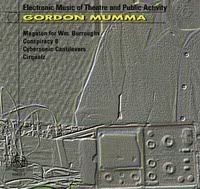Electronic Music for Theatre and Public Activity

Megaton for Wm.Burroughs
Conspiracy 8
Cybersonic Cantilevers
Cirqualz
Gordon Mumma (b. 1935) has played a pioneering role in the development and evolution of “live-electronic” music. “Live-electronics” as a concept and practice appears to have originated in the United States in the late 1950s, outside the few institutional electronic studios and often in the context of innovative theatre activity. From its inception, it frequently involved two processes: (1) live performance with accompanying or interacting sound materials on magnetic tape; and (2) the use of electronic circuitry as sound-modifying and sound-producing instruments.
Beginning with his classic Megaton for Wm. Burroughs of 1963, Mumma’s live-electronic and cybersonic works of the 1960s and 1970s, especially Medium Size Mograph (1963) and Hornpipe (1967), display his resourceful use of both live-electronic processes. Cybersonic Cantilevers (1973) extends them to include the active participation of audience members, many of them children and teenagers who were quick to grasp the artistic potential of cybersonic technology, while Conspiracy 8 (1969–70) is an early example of live interaction between performers and computer. A major addition to the contemporary music discography, this is essential listening for anyone interested in the history of electronic music.
Megaton for Wm. Burroughs, Conspiracy 8 (co-composed and performed with Stephen Smoliar), Cybersonic Cantilevers, Cirqualz
http://rapidshare.com/files/44161600/Gordon_Mumma.part1.rar.html
http://rapidshare.com/files/44163616/Gordon_Mumma.part2.rar.html

1 comment:
THX!!!
Post a Comment